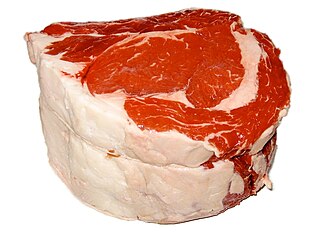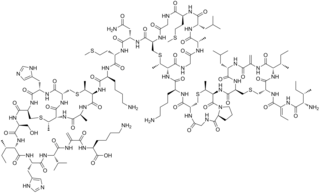Related Research Articles

Food preservation includes processes that make food more resistant to microorganism growth and slow the oxidation of fats. This slows down the decomposition and rancidification process. Food preservation may also include processes that inhibit visual deterioration, such as the enzymatic browning reaction in apples after they are cut during food preparation. By preserving food, food waste can be reduced, which is an important way to decrease production costs and increase the efficiency of food systems, improve food security and nutrition and contribute towards environmental sustainability. For instance, it can reduce the environmental impact of food production.

Beef is the culinary name for meat from cattle. Beef can be prepared in various ways; cuts are often used for steak, which can be cooked to varying degrees of doneness, while trimmings are often ground or minced, as found in most hamburgers. Beef contains protein, iron, and vitamin B12. Along with other kinds of red meat, high consumption is associated with an increased risk of colorectal cancer and coronary heart disease, especially when processed. Beef has a high environmental impact, being a primary driver of deforestation with the highest greenhouse gas emissions of any agricultural product.

Jerky is lean trimmed meat cut into strips and dehydrated to prevent spoilage. Normally, this drying includes the addition of salt to prevent bacteria growth. The word "jerky" derives from the Quechua word ch'arki which means "dried, salted meat".

Salami is a cured sausage consisting of fermented and air-dried meat, typically pork. Historically, salami was popular among southern, eastern, and central European peasants because it can be stored at room temperature for up to 45 days once cut, supplementing a potentially meager or inconsistent supply of fresh meat. Countries and regions across Europe make their own traditional varieties of salami.

Nisin is a polycyclic antibacterial peptide produced by the bacterium Lactococcus lactis that is used as a food preservative. It has 34 amino acid residues, including the uncommon amino acids lanthionine (Lan), methyllanthionine (MeLan), didehydroalanine (Dha), and didehydroaminobutyric acid (Dhb). These unusual amino acids are introduced by posttranslational modification of the precursor peptide. In these reactions a ribosomally synthesized 57-mer is converted to the final peptide. The unsaturated amino acids originate from serine and threonine, and the enzyme-catalysed addition of cysteine residues to the didehydro amino acids result in the multiple (5) thioether bridges.

Beef aging or ageing is a process of preparing beef for consumption by aging it, in order to break down the connective tissue within the meat.

Pancetta is a salt-cured pork belly meat product in a category known as salume. In Italy, it is often used to add depth to soups and pastas.

Modified atmosphere packaging (MAP) is the practice of modifying the composition of the internal atmosphere of a package in order to improve the shelf life. The need for this technology for food arises from the short shelf life of food products such as meat, fish, poultry, and dairy in the presence of oxygen. In food, oxygen is readily available for lipid oxidation reactions. Oxygen also helps maintain high respiration rates of fresh produce, which contribute to shortened shelf life. From a microbiological aspect, oxygen encourages the growth of aerobic spoilage microorganisms. Therefore, the reduction of oxygen and its replacement with other gases can reduce or delay oxidation reactions and microbiological spoilage. Oxygen scavengers may also be used to reduce browning due to lipid oxidation by halting the auto-oxidative chemical process. Besides, MAP changes the gaseous atmosphere by incorporating different compositions of gases.

Chicken is the most common type of poultry in the world. Owing to the relative ease and low cost of raising chickens—in comparison to mammals such as cattle or hogs—chicken meat and chicken eggs have become prevalent in numerous cuisines.

Vacuum packing is a method of packaging that removes air from the package prior to sealing. This method involves placing items in a plastic film package, removing air from inside and sealing the package. Shrink film is sometimes used to have a tight fit to the contents. The intent of vacuum packing is usually to remove oxygen from the container to extend the shelf life of foods and, with flexible package forms, to reduce the volume of the contents and package.

Food packaging is a packaging system specifically designed for food and represents one of the most important aspects among the processes involved in the food industry, as it provides protection from chemical, biological and physical alterations. The main goal of food packaging is to provide a practical means of protecting and delivering food goods at a reasonable cost while meeting the needs and expectations of both consumers and industries. Additionally, current trends like sustainability, environmental impact reduction, and shelf-life extension have gradually become among the most important aspects in designing a packaging system.

Meat science is the study of meat, including its production, preparation and preservation. Some meat scientists are studying methods of producing artificial meat such as cultures of muscle cells.

A superabsorbent polymer (SAP) (also called slush powder) is a water-absorbing hydrophilic homopolymers or copolymers that can absorb and retain extremely large amounts of a liquid relative to its own mass.

Instant soup is a type of soup designed for fast and simple preparation. Some are homemade, and some are mass-produced on an industrial scale and treated in various ways to preserve them. A wide variety of types, styles and flavors of instant soups exist. Commercial instant soups are usually dried or dehydrated, canned, or treated by freezing.
The terms active packaging, intelligent packaging, and smart packaging refer to amplified packaging systems used with foods, pharmaceuticals, and several other types of products. They help extend shelf life, monitor freshness, display information on quality, improve safety, and improve convenience.

Food spoilage is the process where a food product becomes unsuitable to ingest by the consumer. The cause of such a process is due to many outside factors as a side-effect of the type of product it is, as well as how the product is packaged and stored. Due to food spoilage, one-third of the world's food produced for the consumption of humans is lost every year. Bacteria and various fungi are the cause of spoilage and can create serious consequences for the consumers, but there are preventive measures that can be taken.

An expiration date or expiry date is a previously determined date after which something should no longer be used, either by operation of law or by exceeding the anticipated shelf life for perishable goods. Expiration dates are applied to selected food products and to some other manufactured products like infant car seats where the age of the product may impact its safe use.
Carbonated milk or soda milk is a carbonated soft drink. It can be made from powdered milk or fresh milk, and often has added flavor. In addition to modified mouth feel, carbonated milk also has a longer shelf-life than similarly processed flat milk and a different flavor. It is sold by several companies and is most popular in Asia.

Case-ready meat, retail-ready meat, or pre-packaged meat refers to fresh meat that is processed and packaged at a central facility and delivered to the store ready to be put directly into the meat case.
Meat water holding capacity (WHC) refers to the ability of meat to retain moisture including moisture inherent to the muscle tissue and any fluids that may be added to the meat during processing. The WHC characteristic corresponds to meat juiciness and meat tenderness.
References
- ↑ Dabo, Mohamed (11 July 2023). "Understanding the functions of an absorbent pad in meat packaging". Packaging Gateway. Retrieved 29 April 2024.
- ↑ "Antimicrobial Absorbent Pad for Reducing Bacterial Contamination of Packaged Poultry". USDA. 2016. Retrieved 30 April 2024.
 This article incorporates text from this source, which is in the public domain .
This article incorporates text from this source, which is in the public domain . - 1 2 Robertson, Gordon L. (22 September 2005). "Packaging of Flesh Foods". Food Packaging: Principles and Practice, Second Edition. CRC Press. pp. 341–342. ISBN 978-0-8493-3775-8 . Retrieved 1 May 2024.
- ↑ "FSIS Directive 7410.1 Rev 1. 7-1-93". Compilation of Meat and Poultry Inspection Issuances. The Service. 1993. Retrieved 30 April 2024.
- ↑ US 7,799,361B2,Etchels,"ABSORBENT FOOD PAD AND METHOD OF USING SAME",published 2010
- ↑ US 6,171,695B1,Fontinot, M C,"THIN ABSORBENT PADS FOR FOOD PRODUCTS",published 2001
- ↑ Fernanddez, A (2010). "Reduction of the Spoilage-Related Microflora in Absorbent Pads by Silver Nanotechnology during Modified Atmosphere Packaging of Beef Meat". Journal of Food Protection. 73 (12): 2263–2369. doi: 10.4315/0362-028X-73.12.2263 . PMID 21219746 . Retrieved 27 April 2024.
- ↑ Castrica, M (2020). "Antibacterial Effect of an Active Absorbent Pad on Fresh Beef Meat during the Shelf-Life: Preliminary Results". Applied Science. 10 (21): 7904. doi: 10.3390/app10217904 . hdl: 2434/785180 .
- ↑ Pettersen, MK; Nilsen-Nygaard, J; Hansen, AÅ; Carlehög, M; Liland, KH (10 June 2021). "Effect of Liquid Absorbent Pads and Packaging Parameters on Drip Loss and Quality of Chicken Breast Fillets". Foods (Basel, Switzerland). 10 (6): 1340. doi: 10.3390/foods10061340 . PMC 8229185 . PMID 34200694.
- ↑ Devine, Carrick; Dikeman, M. (22 July 2014). "Requirements for Overwrapped Packages". Encyclopedia of Meat Sciences. Elsevier. p. 15. ISBN 978-0-12-384734-8 . Retrieved 1 May 2024.
- ↑ Casson, Andrea; Giovenzana, Valentina; Frigerio, Valeria; Zambelli, Martina; Beghi, Roberto; Pampuri, Alessia; Tugnolo, Alessio; Merlini, Annachiara; Colombo, Lorenzo; Limbo, Sara; Guidetti, Riccardo (December 2022). "Beyond the eco-design of case-ready beef packaging: The relationship between food waste and shelf-life as a key element in life cycle assessment". Food Packaging and Shelf Life. 34: 100943. doi:10.1016/j.fpsl.2022.100943. hdl: 2434/937665 .
- ↑ Jiao, Xiangyu; Xie, Jiaxuan; Du, Haiyu; Bian, Xiaochun; Wang, Changtao; Zhou, Liping; Wen, Yongqiang (June 2023). "Antibacterial smart absorbent pad with Janus structure for meat preservation". Food Packaging and Shelf Life. 37: 101066. doi:10.1016/j.fpsl.2023.101066 . Retrieved 30 April 2024.
- ↑ Chelladurai, Vellaichamy; Jayas, Digvir S. (15 November 2018). "Chapter 8. Applications in the Meat industry". Nanoscience and Nanotechnology in Foods and Beverages. CRC Press. pp. 219–239. ISBN 978-1-351-64920-9 . Retrieved 30 April 2024.
- ↑ Li, X; Zhang, R; Hassan, MM; Cheng, Z; Mills, J; Hou, C; Realini, CE; Chen, L; Day, L; Zheng, X; Zhang, D; Hicks, TM (19 September 2022). "Active Packaging for the Extended Shelf-Life of Meat: Perspectives from Consumption Habits, Market Requirements and Packaging Practices in China and New Zealand". Foods (Basel, Switzerland). 11 (18): 2903. doi: 10.3390/foods11182903 . PMC 9506090 . PMID 36141031.
- ↑ He, Y; Li, B; Du, J; Cao, S; Liu, M; Li, X; Ren, D; Wu, X; Xu, D (15 March 2022). "Development of pH-responsive absorbent pad based on polyvinyl alcohol/agarose/anthocyanins for meat packaging and freshness indication". International Journal of Biological Macromolecules. 201: 203–215. doi:10.1016/j.ijbiomac.2021.12.171. PMID 34995663.
- ↑ "Meat and Poultry Packaging Materials". USDA. Mar 24, 2015. Retrieved 29 April 2024.
- ↑ HOUSTON, GILLIE (April 24, 2023). "What's That Absorbent Pad in My Meat Packaging (And What Happens if I Cooked It)?". Simply Recipes. Retrieved 29 April 2024.
- ↑ Ryan, John M. (19 October 2015). Food Fraud. 3.4.7 Weight Fraud: Academic Press. p. 39. ISBN 978-0-12-803398-2.
{{cite book}}: CS1 maint: location (link)

